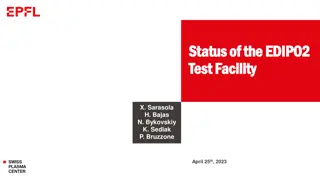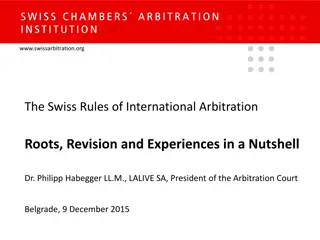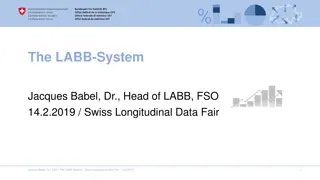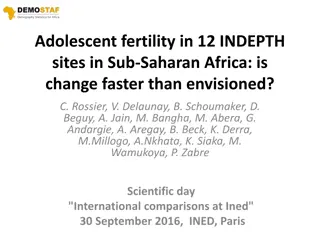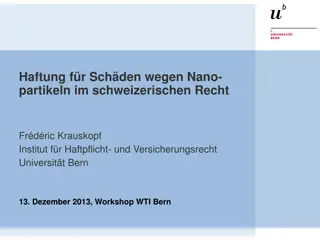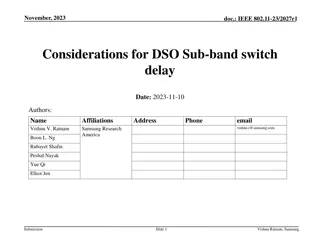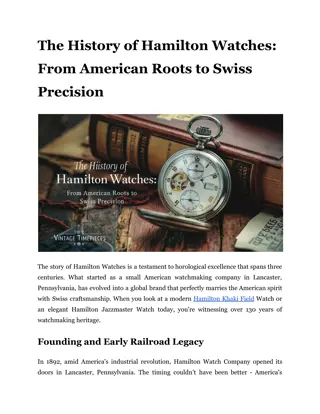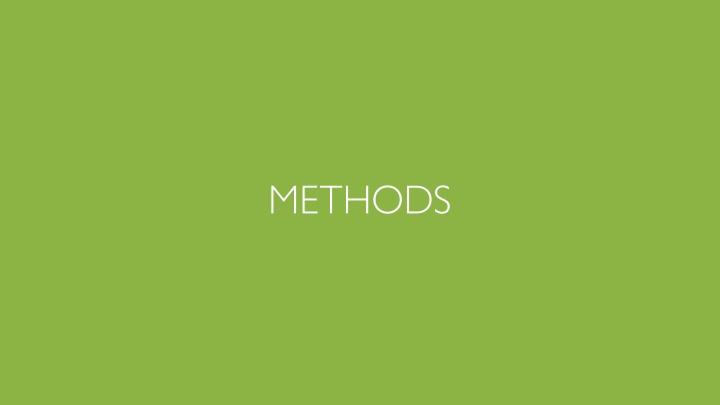
Insights into Survey Populations and Results in Switzerland
Discover the diverse target populations for questionnaire domains in Switzerland, including adults with Osteogenesis Imperfecta (OI), caregivers, adolescents with OI, care recipients, and more. Explore the impact of OI on individuals and caregivers, as well as the clinical and socioeconomic aspects analyzed in the survey populations.
Download Presentation

Please find below an Image/Link to download the presentation.
The content on the website is provided AS IS for your information and personal use only. It may not be sold, licensed, or shared on other websites without obtaining consent from the author. If you encounter any issues during the download, it is possible that the publisher has removed the file from their server.
You are allowed to download the files provided on this website for personal or commercial use, subject to the condition that they are used lawfully. All files are the property of their respective owners.
The content on the website is provided AS IS for your information and personal use only. It may not be sold, licensed, or shared on other websites without obtaining consent from the author.
E N D
Presentation Transcript
Target populations for questionnaire domains Adult with OI Adult with OI caregivers and caregivers) Caregiver Caregiver Adolescent with OI Adolescent with OI Care recipient Care recipient Relative Relative (non (non- -caregivers and caregivers) (with or without OI) (with or without OI) My OI My OI My OI My OI Care recipient s OI Care recipient s OI Clinical characteristics Clinical characteristics Impact of caring for Impact of caring for someone with OI someone with OI Socioeconomic Humanistic Impact of OI on my & my Impact of OI on my & my relative s life with OI relative s life with OI Socioeconomic Humanistic Clinical characteristics Clinical characteristics Impact of OI on care Impact of OI on care recipient s life recipient s life Socioeconomic Humanistic Impact of my OI on my life Impact of my OI on my life Socioeconomic Humanistic Impact of my OI on my life Impact of my OI on my life Socioeconomic Humanistic Proxy data KE Self-reported data Y Methods Abbreviations: Abbreviations: CG, caregiver; OI, osteogenesis imperfecta. 2
Populations used in the analysis a Respondents Respondents Proxy respondents Proxy respondents Non Non- -CGs with OI CGs with OI Adults with OI Adults with OI CGs with OI CGs with OI Proxy children with OI Adolescents with OI Adolescents with OI Proxy adolescents with OI CG without OI CG without OI Proxy adults with OI Relatives Relatives Methods Abbreviations: Abbreviations: CG, caregiver; OI, osteogenesis imperfecta. Notes: Notes: aFor more details about the survey populations, see Appendix A1.1 and A1.2. 3
Survey populations a,b,c Respondent population (n=36) Respondent population (n=36) Proxy respondent population (n=12) Proxy respondent population (n=12) Proxy responses provided by 23 CGs Proxy responses provided by 23 CGs 27 27 CGs with OI CGs with OI n=4 n=4 7 7 Non Non- -CGs n=27 n=27 CGs 3 3 8 8 2 2 1 1 Adults with OI Adults with OI CGs without OI CGs without OI Adolescents with OI Adolescents with OI Close relatives Close relatives Proxy children with OI Proxy children with OI Proxy adolescents with OI Proxy adolescents with OI Proxy adults with OI Proxy adults with OI Figure 29. The Swiss survey populations Figure 29. The Swiss survey populations Source Appendix A2.1 CH Results: Switzerland (CH) Abbreviations Abbreviations: CG, caregiver; CH, Switzerland; OI, osteogenesis imperfecta. Notes Notes: a Adults 18, adolescents 12 17, children 0 11; b CGs without OI consist of CGs of children with OI, adolescents with OI and/or adults with OI; cpopulations with <10 individuals are not further analysed 5
Overall demographics a Adolescents with Adolescents with OI (n=0) OI (n=0) b b Adults with OI Adults with OI (n=27) (n=27) Includes CGs with OI (n=4) Relatives Relatives (n=1) (n=1) Care recipients with OI Care recipients with OI (n=12) (n=12) CGs without OI CGs without OI (n=8) (n=8) Children: 5 (5) Adolescents: 17 (17) Adults: 22 (22) Age (y) Age (y) c c mean (median) mean (median) 41 (43) N/A 44 (44) 46 (49) Children: 3 (43) Adolescents: 0 (0) Adults: 1 (50) Gender Gender d d female, n (%) female, n (%) 1 (100) 13 (48) N/A 7 (88) Results: Switzerland (CH) Abbreviations Abbreviations: : CG, caregiver; CH, Switzerland; N/A. not available; OI, osteogenesis imperfecta. Notes Notes: a Adults 18, adolescents 12 17, children 0 11 b bDue to the small number of adolescents and proxy respondents, no additional analysis can be performed; cAppendix A2.1, A2.2 d Appendix A2.3 6
Age distribution Age distribution all respondents with OI A 35% The age of Swiss adults with OI ranged from 30 The age of Swiss adults with OI ranged from 30 75 y, that of proxy respondents, 2 proxy respondents, 2 23 y 23 y 75 y, that of 30% 25% 20% 15% For the respondents with OI, the 31 40-year group is the largest, the 18 30 is the smallest. 10% 5% 0% For the proxy respondents with OI, the 0 5, 6 11 and 12 17-year groups are the largest, the 18 30 is the smallest. 12 17 y 18 30 y 31 40 y 41 50 y 51 60 y 61+ Age distribution all proxy respondents with OI B 35% 30% 25% 20% 15% 10% 5% 0% 0-5y 6-11y 12 17 y 18 30 y 31 40 y 41 50 y Figure 30. Age distributions of survey respondents (n=27; A) and proxy respondents (n=12; B). Figure 30. Age distributions of survey respondents (n=27; A) and proxy respondents (n=12; B). Source: Appendix A2.2 CH Results: Switzerland (CH) Abbreviations: Abbreviations: CH, Switzerland; OI, osteogenesis imperfecta. 7
OI severity a,b OI severity The largest proportion of Swiss adults rated their OI as mild to The largest proportion of Swiss adults rated their OI as mild to moderate (30% moderate (30% 48%) 48%) 4% 7% 11% Adults with severe OI comprised 11% of the total population. However, 7% did not know and 4% preferred not to say. 48% 30% Adults with OI (n=27) Mild Moderate Severe I don t know Prefer not to say Figure 31. Self Figure 31. Self- -reported OI severity. reported OI severity. Source: Appendix A3.1 CH Results: Switzerland (CH) Abbreviations Abbreviations: CH, Switzerland; OI, osteogenesis imperfecta. Notes Notes: a Adults 18, adolescents 12 17, children 0 11; bpopulations with <10 individuals are not further analysed 8
OI type a,b OI type 4% 4% OI type 1 and 3 were the most reported types in Swiss adults, OI type 1 and 3 were the most reported types in Swiss adults, however many participants did not know their OI type however many participants did not know their OI type 19% The proportions of respondents reporting each OI type varied. Type 1 OI was the most frequently reported OI type within the adult population (41%). 41% 15% of adults had an undefined type OI. Type 4 and other types were evenly represented. 19% 15% Adult with OI (n=27) Undefined type Type 4 (IV) Type 10 (X) Type 16 (XVI) I don't know Type 5 (V) Type 11 (XI) Type 17 (XVII) Prefer not to say Type 6 (VI) Type 12 (XII) Type 18 (XVIII) Type 1 (I) Type 7 (VII) Type 13 (XIII) Other Type 2 (II) Type 8 (VIII) Type 14 (XIV) Type 3 (III) Type 9 (IX) Type 15 (XV) Figure 32. Self Figure 32. Self- -reported OI type. reported OI type. Source: Appendix A3.2 CH Results: Switzerland (CH) Abbreviations: Abbreviations: CH, Switzerland; OI, osteogenesis imperfecta. Notes Notes: a Adults 18, adolescents 12 17, children 0 11; bpopulations with <10 individuals are not further analysed 9
Impact of OI on QoL domains a,b Impact of OI on QoL of adults with OI 100% OI has impacted many areas of the lives of Swiss adults with OI has impacted many areas of the lives of Swiss adults with OI, ranging from their careers to their leisure activities OI, ranging from their careers to their leisure activities 90% 80% 70% 60% Areas that were most often mildly-severely impacted were leisure activities (78%), career and job choices (45% 56%), and work hours (56%). 50% 40% 30% 20% 10% Over a quarter of Swiss adults with OI reported a mild- severe impact on all other quality of life domains. 0% Severely impacted Moderately impacted Mildly impacted Very mildly impacted Not impacted I don't know Prefer not to say Not applicable Missing Figure 33. Impact of OI on QoL of adults with OI (n=27). Figure 33. Impact of OI on QoL of adults with OI (n=27). Source: Appendix A6.1 CH Results: Switzerland (CH) Abbreviations: Abbreviations: CH, Switzerland; OI, osteogenesis imperfecta; QoL, quality of life. Notes Notes: a Adults 18; bpopulations with <10 individuals are not further analysed 10
Worries and concerns a,b Worries and concerns of adults with OI 100% Over half of all Swiss adults with OI worried a lot about Over half of all Swiss adults with OI worried a lot about fractures (59%) and ageing (52%) fractures (59%) and ageing (52%) 90% 80% 70% 60% Over two thirds of Swiss adults worried about loss of mobility, independence, ability to self-care, OI complications and access to healthcare. 50% 40% 30% 20% 10% Fewer respondents worried about family and romantic relations, however this still represented over a third of Swiss adults with OI. 0% Worry a lot Worry a little Don't worry Not applicable I don't know Prefer not to say Figure 34. Proportion of adults with OI (n=27) worried and concerned about different quality of life domains. Figure 34. Proportion of adults with OI (n=27) worried and concerned about different quality of life domains. Source: Appendix A6.2 CH Results: Switzerland (CH) Abbreviations: Abbreviations: CH, Switzerland; OI, osteogenesis imperfecta. Notes Notes: a Adults 18; bpopulations with <10 individuals are not further analysed 11
Summary of Swiss dataset 1 1 Key findings Key findings Female respondents made up the majority of the survey dataset (70% of adults with OI) Of the adult respondents with OI, 31 40 and >60-year-olds made up the largest age group (30% and 26%, respectively) Most adults with OI reported the severity as moderate (48%), with a large proportion rating the severity as mild (30%) and 11% of respondents rated severity as severe 41% of adult respondents reported having type 1 OI. OI type 3 and unknown OI are present in equal proportions within the population (19% each) High proportions of Swiss adults reported a mild-severe impact on types of leisure activities (78%), work hours (56%) and job types (56%) A high proportion of adults reported worrying a lot about future fractures (59%), ageing (52%), loss of mobility (44%) and OI complications (44%). Fewer Swiss adults with OI reported worrying a lot about family and romantic relationships CONCLUSION 3 3 Strengths of the Swiss dataset Strengths of the Swiss dataset Weaknesses of the Swiss dataset Weaknesses of the Swiss dataset 2 2 Due to the small number of respondents, the self-reported adolescent and proxy reported adults, adolescents and children are not analysed This sample cannot be considered representative of the Swiss OI community as a whole due to the small sample size of respondents across subgroups The sample included very few male respondents (30%) The survey has produced a data set which provide key insights into the OI landscape of Switzerland, which has been difficult to assess and quantify in the past 12 Abbreviations: Abbreviations: CH, Switzerland; OI, osteogenesis imperfecta.

